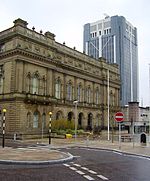Blackburn Rural District
Districts of England abolished by the Local Government Act 1972Districts of England created by the Local Government Act 1894History of LancashireLocal government in Blackburn with DarwenRural districts of England ... and 1 more
Use British English from August 2012
Blackburn was a rural district in Lancashire from 1894 to 1974. It was named after, but did not include Blackburn, which was an independent county borough. It surrounded Blackburn on the north and western sides, and also included an exclave on the south-eastern side of Blackburn, consisting of the parishes of Yate and Pickup Bank and Eccleshill. It was created in 1894 under the Local Government Act 1894. It lost the parish of Witton to Blackburn in the 1930s. In 1974, under the Local Government Act 1972, the district was abolished. Its territory was split between the new districts of Blackburn and Ribble Valley.
Excerpt from the Wikipedia article Blackburn Rural District (License: CC BY-SA 3.0, Authors).Blackburn Rural District
Cathedral Square,
Geographical coordinates (GPS) Address Website Nearby Places Show on map
Geographical coordinates (GPS)
| Latitude | Longitude |
|---|---|
| N 53.747 ° | E -2.48 ° |
Address
Premier Inn Blackburn Town Centre
Cathedral Square 3
BB1 1FB , Queen's Park
England, United Kingdom
Open on Google Maps








